3D is an entirely different kind of illusion if 2D animation is a magic trick!
Both will leave you mesmerized if done well!
However, the biggest difference?
2D animators complain about drawing hands; 3D animators complain about rigging them!
Still can’t decide between 2D and 3D animation? Just remember, Spider-Man did both in “Into the Spider-verse” and crushed it!
Ever wondered why some animated movies feel like a nostalgic flipbook masterpiece while others look like they popped straight out of a video game?
Well, that’s what separates 2D and 3D animation magic!
Two different approaches that each have their ways of making stories come to life!
This guide fully breaks down everything, from hand-drawn appeal to incredibly lifelike computer graphics, so you can finally put an end to the argument!
Or at least impress your friends with your newfound animation knowledge! Let’s explore!
Relatable Read: Top 20 Animation Styles (With Influencing Examples)
At A Glance: 2D vs. 3D Animation
| Feature | 2D Animation | 3D Animation |
| Dimensionality | Flat, two-dimensional | Depth, three-dimensional |
| Visual Appeal | Artistic, stylish, hand-drawn | Realistic, lifelike |
| Creation Process | Frame-by-frame drawing | Modeling, rigging, rendering |
| Cost and Time | Generally lower cost and faster | Higher cost and longer production |
| Flexibility | Limited, redrawing needed for changes | High, easier adjustments |
The Essence of 2D and 3D Animation
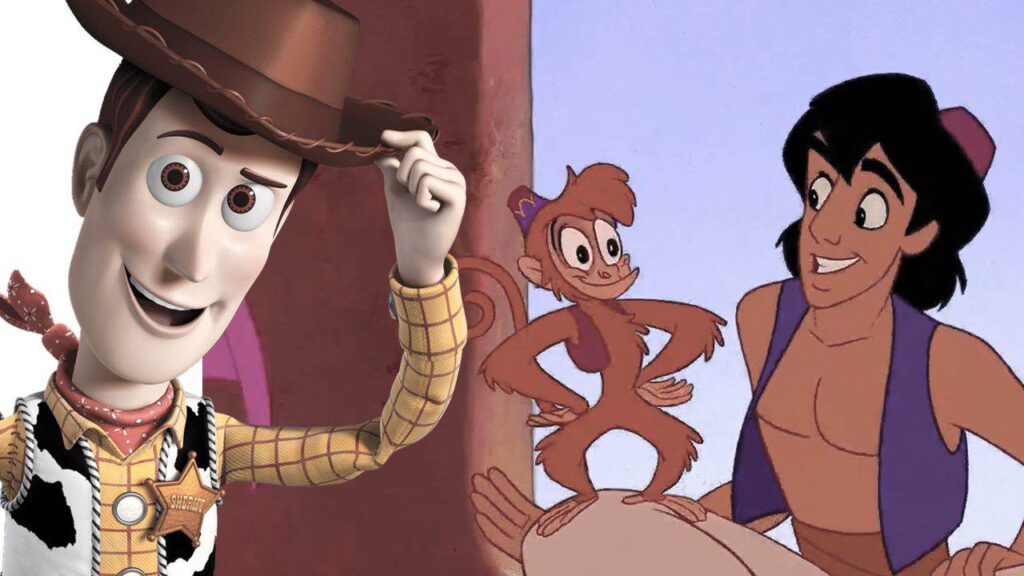
[Source: Bloopanimation]
What is 2D Animation?
2D animation works in a two-dimensional space with an emphasis on width and height. The term “traditional” animation is a popular way to describe it.
In 2D animation, a sequence of images, or “frames,” is created that, when viewed rapidly one after the other, seems to move.
Hand-drawn techniques are the first where each frame was meticulously made on paper or celluloid. 2D animation has its roots in this art form and was made possible by early 20th-century pioneers like Walt Disney and Winsor McCay.
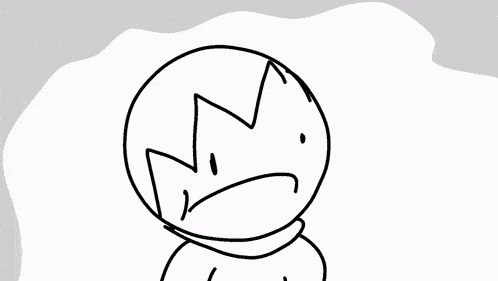
[Source: giftenor]
Traditional Hand-Drawn Techniques Transitioning to Digital Platforms
Although animation is still done by hand, digital tools have completely changed the process. Software streamlines production and increases creative possibilities by enabling animators to digitally generate, edit, and manipulate frames.
Digital 2D animation offers more versatility and efficiency while maintaining the hand-drawn look.
Some examples of 2D animations are “Tom and Jerry,” “Looney Tunes,” and “The Simpsons.”
Relatable Read: Top 2D Animation Companies In The USA (2025) – Top 10 Picks
What is 3D Animation?
3D animation works in three dimensions. It gives the visual experience more depth. It makes use of computer-generated imagery (CGI) to produce virtual environments and 3D models.
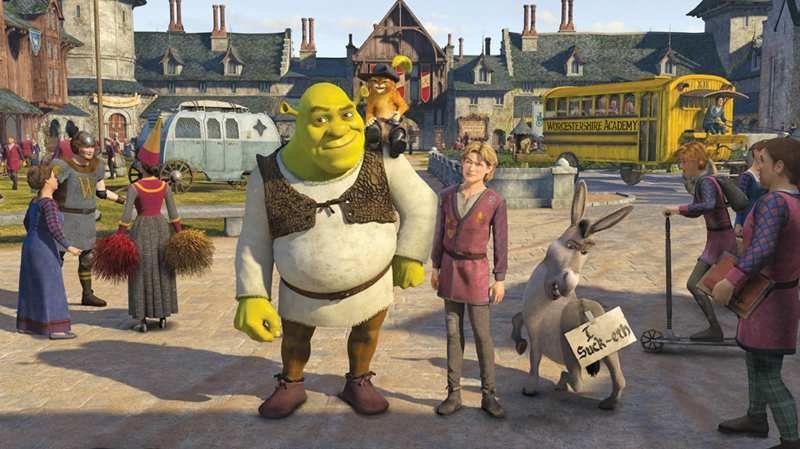
[Source: Researchgate]
To move, animators work with these models. Over time, they change their
- Locations
- Rotations
- Deformations
Relatable Read: Complete Animation Video Production Process: Step-by-step Guide (2025)
The growth of 3D animation has been propelled by advancements in processing power and software. These have enabled the production of ever-more complex and realistic visuals.
Some examples of 3D animations are “Toy Story,” “Frozen,” and “Shrek”.
Check this out:
Understand The Key Differences Between 2D and 3D Animation
The art of making pictures come to life: 2D and 3D. Each has unique characteristics that affect how they are used and how it look.
Dimensionality and Visual Appeal
| Flat Imagery | Depth Perception |
| 2D animation produces flat-looking visuals by working in a two-dimensional plane. There is no depth because characters and settings are rendered or drawn on a single plane. | 3D animation uses three-dimensional space. The depth of the models and environments allows creators to show realistic views and camera movements. |
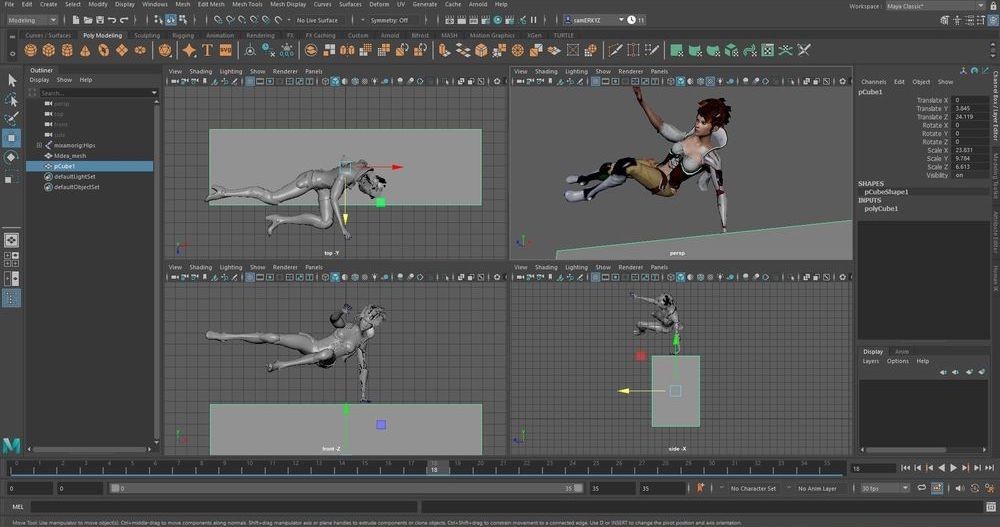
[Source: Rokoto]
Artistic charm of 2D vs. realism of 3D
| Artistic Charm | Realism |
| A stylized, artistic look is frequently adopted in 2D animation. Its hand-drawn style can evoke feelings of whimsical appeal and nostalgia. | 3D animation tries to look and feel like the real world. This method helps animators create lifelike movements and detailed visuals |
Relatable Read: Green Screen vs. Blue Screen: Which One Do You Need?
Creation Process
| Frame by Frame Drawing in 2D | Modeling, Rigging, Rendering in 3D |
| In this drawing, artists create every movement by hand or with digital tools. This process is a key part of 2D animation. It takes time, but it creates unique and artistic results. | Making digital models, rigging them with a virtual skeleton to allow for movement, and rendering the finished scenes are all steps in 3D animation. Technical know-how and specific software are needed for this process. |
Cost and Time Investment
| 2D Animation | 3D Animation |
| 2D animation is frequently faster and less expensive to make because of its simplified production pipeline.; Particularly for projects with tight budgets. | More resources are needed for 3D animation, such as Strong computersSpecialized softwareTalented animatorsIt does, however, provide more flexibility about lighting, camera movement, and realistic effects. |
Flexibility and Modification
| 2D Animation | 3D Animation |
| It may be difficult to alter a 2D animation since it frequently needs redrawing frames. As a result, the time and expense of production may increase. | 3D animation makes it easier to adjust models and scenes. Models, lighting, and camera angles can all be altered without much redrawing. |
Relatable Read: How To Storyboard? – Step-by-Step Ultimate Guide For 2025
Pros and Cons of 2D and 3D Animation
| Type | Pros | Cons |
|---|---|---|
| 2D Animation | Simple and Timeless Appeal | Limited Depth and Realism |
| Cost Effectiveness | Reduced Adaptability in Scene Change | |
| Strong Artistic Expression | ||
| 3D Animation | High Realism and Detail | Increased Production Costs |
| Increased Model Flexibility and Reusability | Extended Development Time |
Applications and Industry Usage
Entertainment
| 2D Animation | 3D Animation |
| Predominates in television cartoons, where a variety of narratives are made possible by its economical and stylistic adaptability. | Powerful films by produced aesthetically beautiful and lifelike characters and settings. |
| Thrives in independent cinema, allowing artists to convey their distinct artistic views with little funding. | Creates realistic simulations and captivating gameplay, which powers the immersive experience of contemporary video games. |
Relatable Read: Film Clapperboard: Your Essential Tool For Professional Video Production
Marketing and Advertising
| 2D Animation | 3D Animation |
| Effectively communicates information in explainer movies by using simple graphics to clarify difficult ideas. | Offers lifelike product demonstrations that thoroughly highlight features and functionalities. |
| Improves infographics by making data easier to understand and more captivating. | Produces immersive ads that captivate viewers with engaging visuals and interactive elements. |
Education and Training
| 2D Animation | 3D Animation |
| Facilitates simple educational material by providing understandable and efficient information. | Great for simple diagrams and concepts. |
| Makes sophisticated simulations possible, facilitating participatory education in disciplines like engineering and medicine. | Builds realistic training situations and immersive training environments for the development of practical skills. |
Relatable Read: 25 Best Marketing YouTube Channels To Follow In 2025
Combining 2D and 3D Animation
The field of animation always advances, and an interesting trend is the merging of 2D and 3D approaches. Animators may produce original and strikingly beautiful outcomes thanks to this hybrid approach, which opens up a world of creative possibilities.
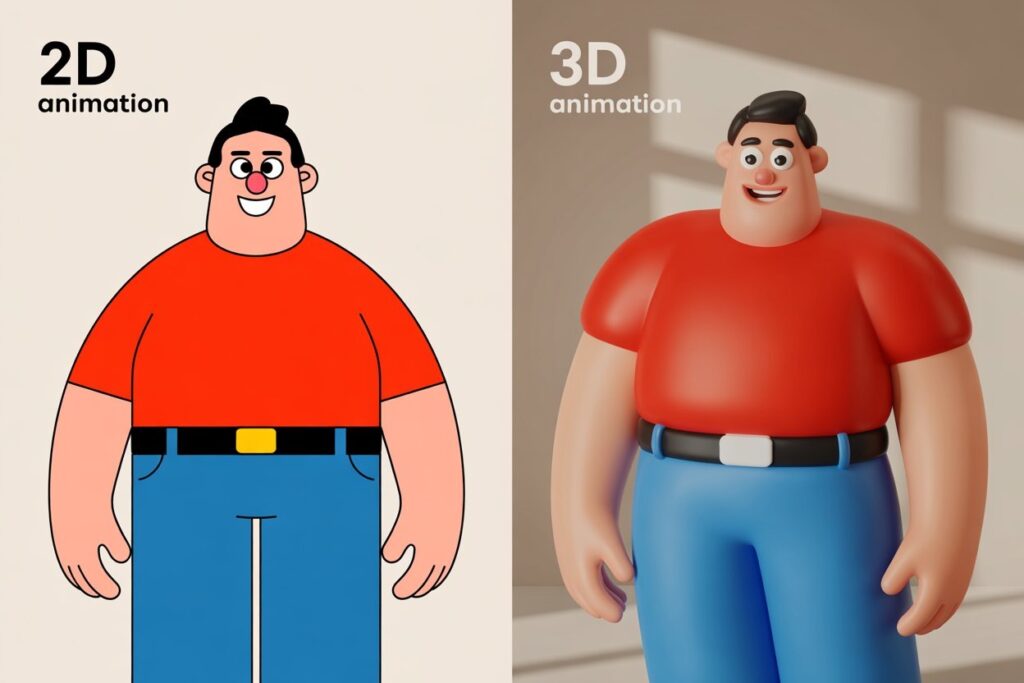
Exploration of hybrid techniques that merge 2D and 3D elements
- This entails incorporating 2D components like stylistic effects or hand-drawn characters smoothly into a 3D setting.
- On the other hand, 3D models can be displayed to have a “2.5D” appearance by simulating the style of 2D animation.
- Software that enables the import and modification of 2D and 3D assets can be used with these techniques.
Benefits of a blended approach in achieving unique visual styles
- Distinct Visual Styles: Unlike standard 2D or 3D animation, hybrid techniques enable unique aesthetics.
- Improved Storytelling: Storytelling can be improved by fusing the depth and realism of 3D with the expressiveness of 2D.
- Creative Flexibility: Greater creative flexibility allows animators to try out a wider variety of styles and effects.
Relatable Read: Storytelling Techniques For Video Production: 10 Methods For Maintaining Audience Attention
Making the Right Choice for Your Project
Choosing between 2D and 3D animation, or a combination of the two, needs careful consideration of many factors.
Factors to Consider
You need to consider some factors before choosing between a 2D and 3D animation. For instance:
- Project goals and brand identity
- Budget and resources
- Time and production timeline
- Target audience and platform
Relatable Read: The Ultimate Guide To E-Commerce Video Marketing In 2025
Aligning animation style with project objectives and target audience
2D animation is frequently chosen for projects aimed at younger audiences or those who want a handcrafted appearance. It is because of its
- Stylized visuals
- Expressive character animation
3D animation is perfect for projects that need a sense of depth and immersion since it is excellent at producing realistic environments and intricate visual effects.
By combining the benefits of each, hybrid animation can close the gap.
Budgetary Considerations and Resource Availability
While 3D animation may need a bigger budget because of the intricacy of modeling and rendering, 2D animation may be more affordable for simpler tasks.
Hybrid animation can be quite resource-intensive and calls for artists with expertise in both disciplines.
Relatable Read: Videographer vs. Video Production Company: Which Is Right For Your Project?
2D or 3D? – Get Help From LocalEyes For The Best Quality Animation
There are advantages to both 2D and 3D animation! While 3D delivers realistic depth and dramatic movement for captivating storytelling, 2D offers a traditional, economical method with creative versatility!
For the best deals in animations or any kind of video, check out LocalEyes Video Production! At LocalEyes, they specialize in creating high-quality animations tailored to your brand’s vision!
So get ready to elevate your content with top-tier animation! Contact LocalEyes today to discuss your project!
FAQ: 2D vs. 3D Animation
Is 2D or 3D animation superior?
Neither is necessarily “better,” since the best option is contingent only on the particular artistic and practical needs of the undertaking.
Why do some people think 3D is superior to 2D?
Because of its realistic depth, complex landscapes, and efficiency in some production workflows, 3D is seen as superior by some.
Does 2D animation have a future?
Far from being outdated, 2D animation is still an important and artistically appreciated medium with a unique appeal that endures across a variety of media.
Is 2D or 3D the norm for anime?
Although anime is primarily 2D, its basic look frequently stays 2D, but it increasingly uses 3D elements for backgrounds, intricate movements, or particular effects.

Executive Producer at LocalEyes Video Production | Emmy Award Winning Producer

![2D vs. 3D Animation: What’s the Difference? [2025 Guide]](https://localeyesit.com/wp-content/uploads/2025/04/2d-vs-3d-animation.jpg)

